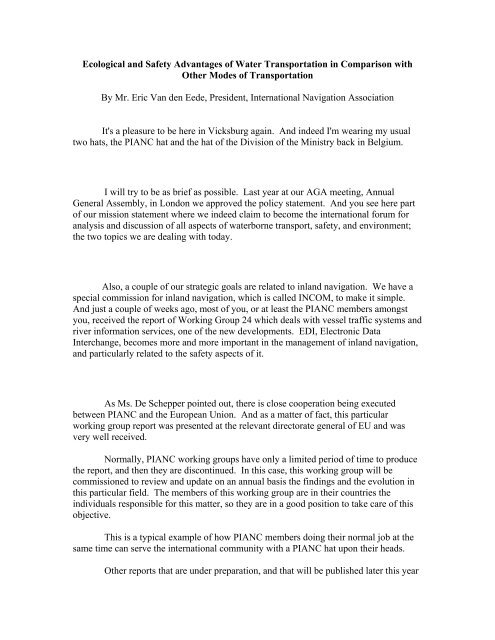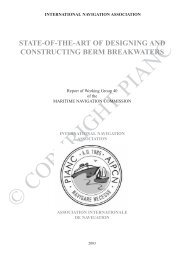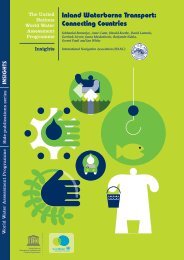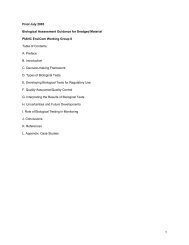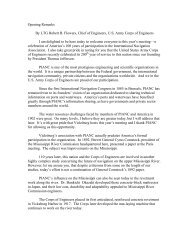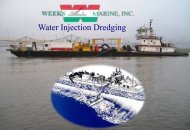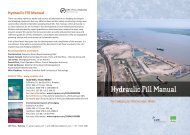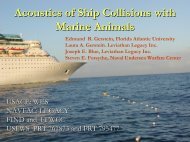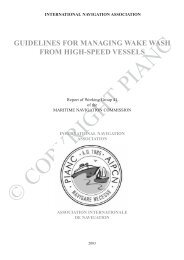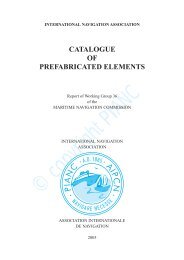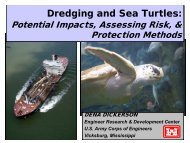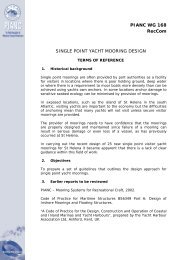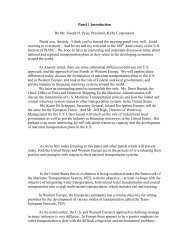Mr. Eric Van den Eede, President, The World Association for ...
Mr. Eric Van den Eede, President, The World Association for ...
Mr. Eric Van den Eede, President, The World Association for ...
You also want an ePaper? Increase the reach of your titles
YUMPU automatically turns print PDFs into web optimized ePapers that Google loves.
Ecological and Safety Advantages of Water Transportation in Comparison with<br />
Other Modes of Transportation<br />
By <strong>Mr</strong>. <strong>Eric</strong> <strong>Van</strong> <strong>den</strong> <strong>Eede</strong>, Presi<strong>den</strong>t, International Navigation <strong>Association</strong><br />
It's a pleasure to be here in Vicksburg again. And indeed I'm wearing my usual<br />
two hats, the PIANC hat and the hat of the Division of the Ministry back in Belgium.<br />
I will try to be as brief as possible. Last year at our AGA meeting, Annual<br />
General Assembly, in London we approved the policy statement. And you see here part<br />
of our mission statement where we indeed claim to become the international <strong>for</strong>um <strong>for</strong><br />
analysis and discussion of all aspects of waterborne transport, safety, and environment;<br />
the two topics we are dealing with today.<br />
Also, a couple of our strategic goals are related to inland navigation. We have a<br />
special commission <strong>for</strong> inland navigation, which is called INCOM, to make it simple.<br />
And just a couple of weeks ago, most of you, or at least the PIANC members amongst<br />
you, received the report of Working Group 24 which deals with vessel traffic systems and<br />
river in<strong>for</strong>mation services, one of the new developments. EDI, Electronic Data<br />
Interchange, becomes more and more important in the management of inland navigation,<br />
and particularly related to the safety aspects of it.<br />
As Ms. De Schepper pointed out, there is close cooperation being executed<br />
between PIANC and the European Union. And as a matter of fact, this particular<br />
working group report was presented at the relevant directorate general of EU and was<br />
very well received.<br />
Normally, PIANC working groups have only a limited period of time to produce<br />
the report, and then they are discontinued. In this case, this working group will be<br />
commissioned to review and update on an annual basis the findings and the evolution in<br />
this particular field. <strong>The</strong> members of this working group are in their countries the<br />
individuals responsible <strong>for</strong> this matter, so they are in a good position to take care of this<br />
objective.<br />
This is a typical example of how PIANC members doing their normal job at the<br />
same time can serve the international community with a PIANC hat upon their heads.<br />
Other reports that are under preparation, and that will be published later this year
deal with the safety of inland navigation and with sustainable river management.<br />
Actually the chairman of this working group works here in Vicksburg. That's <strong>Mr</strong>. Craig<br />
Fischenich.<br />
You have listed here all the effects that should be considered when comparing the<br />
different modes of transport. I picked some graphs from a dedicated website in Europe<br />
related to inland navigation, but I guess most of you are familiar with those figures. So, I<br />
don't think it's useful to go into any details.<br />
But specifically, <strong>for</strong> <strong>den</strong>sely populated continents like Western Europe, perhaps<br />
these are relevant figures when you compare the land use you need <strong>for</strong> the same transport<br />
capacity. And if you put road at 100, you see that inland navigation needs just 10 percent<br />
of the space to be able to transport the same amount of goods.<br />
Also, very remarkable both the French and the German governments<br />
commissioned studies to make comparisons between the social costs of road and inland<br />
navigation, and you see the results are nearly the same. It's a factor of about 14 times<br />
more social impacts related to road transport than to inland navigation.<br />
Now, another aspect, and perhaps the title is a bit confusing, but I put ecological<br />
threats in this respect that I want to give a warning that we are sometimes too self<br />
confi<strong>den</strong>t. And you know the first session was a typical example. We consider inland<br />
navigation as the safest and the most environmentally friendly mode.<br />
But the problem is that the general public, and in particular the decision makers<br />
are not always aware of that or don't agree at all. So, we should be proactive and able to<br />
better market the product of inland navigation. And we should do it in a practical way,<br />
already coming up with solutions <strong>for</strong> questions that will inevitably be raised.<br />
I listed some here. Destruction or loss of habitat especially in Europe, but also<br />
here in the U.S. Whenever there's a new project of inland navigation, of course, you have<br />
to put it somewhere so it consumes land. It might create loss of habitat, then you have to<br />
compensate this loss, et cetera. Splitting up of landscapes, disturbance of ecological<br />
systems, risk of pollution caused by acci<strong>den</strong>ts.<br />
<strong>The</strong>n shifting to safety aspects. Everyone agrees navigation is by far the safest<br />
mode of transport. And there are far less acci<strong>den</strong>ts per ton kilometer than by any other<br />
mode. But I put here a little simple <strong>for</strong>mula. Risk as a product of frequency and impact.<br />
Let me explain it in a simple way. When there's a truck loaded with dangerous goods,<br />
and there's a collision or an acci<strong>den</strong>t, let's say it might impact the next block.<br />
If a river, a main waterway which normally passes through the center of major
cities has the same goods in a much higher quantity, then there is a collision, it's not just<br />
the next block, but perhaps the whole of the center of the city which might be destroyed.<br />
Of course, my point is the frequency of acci<strong>den</strong>ts is let's say negligible. But if<br />
something happens, the impact might be much bigger. So the risk in total, is hard to<br />
predict in advance.<br />
A number of countries, <strong>for</strong> example, the Netherlands, but other countries are<br />
following, are establishing contours, lines of maximum risk that can be tolerated. If then<br />
the center of a city lies within the boundaries of a risk, this might have as a consequence<br />
that navigation would be more strictly regulated, <strong>for</strong> example, not allowing the crossing<br />
of two vessels within the limits of the city.<br />
Perhaps this might <strong>for</strong> some of you seem a bit far-fetched, but I think we should<br />
be aware of these kinds of problems and also be aware that the solutions to deal with<br />
these problems are already available. For example, these river in<strong>for</strong>mation services and<br />
vessel traffic systems are a tool to better monitor the movements of our inland navigation<br />
vessels.<br />
Lets look at safety threats. Indeed one of the particular problems now in Europe<br />
is that the increase in inland navigation entails more ship movements and more chance of<br />
acci<strong>den</strong>ts. Also the ‘just-in-time’ concept might create hazards. We have developed a<br />
number of inland navigation terminals <strong>for</strong> containers. So, it's obvious when those vessels<br />
need to be in the port at a given time because a sea going vessel is going to leave at a<br />
certain hour, they should be there, or otherwise they are having a big problem. So, I don't<br />
need to describe that this might result in neglecting safety and speed limitations.<br />
Also, the scarcity of skilled personnel. Recently our waterborne police has<br />
undertaken an action to i<strong>den</strong>tify the crew members on the vessels. Because, due to the<br />
lack of personnel on the market, illegal or certainly not fully qualified, sailors from<br />
Eastern European countries are working on inland navigation vessels. And these are not<br />
always familiar with all the safety precautions.<br />
Another potential threat is the unskilled recreational boaters which appear<br />
everywhere and which not only endanger themselves, but also the commercial<br />
navigation.<br />
Within the EU a difficult discussion is going on regarding the internalization of<br />
external costs. <strong>The</strong>re are four approaches, and they are depen<strong>den</strong>t indeed on both nation<br />
and time.<br />
Let me tell you a little story. A couple of years ago together with our French<br />
colleagues, we were undertaking an economical study about the liaison between the Seine<br />
and Scheldt river basins, corresponding with the Paris region and the Belgian and Dutch<br />
North Sea ports.
We need to discuss in the Steering Committee a number of boundary conditions<br />
within a time frame until 2010. <strong>The</strong> idea was that by then due to the ef<strong>for</strong>ts the European<br />
Union has undertaken that about 50 percent of the external costs should be internalized<br />
by road pricing and all kinds of other measures. But our French colleagues disapproved,<br />
and they told us this would be totally and politically impossible in France. So, we had<br />
two scenarios. One that in France, Germany, Holland, and Belgium we would have 50<br />
percent of internalization.<br />
But the more realistic scenario was that indeed Germany, Belgium, and Holland<br />
would have this 50 percent. But in France only 15 because they feared that if the French<br />
government would undertake such measures, the truckers would block all the highways<br />
and the economy would come to a standstill.<br />
A couple of weeks after we made this decision, the French government increased<br />
the fuel tax. And all of a sud<strong>den</strong> and probably you remember this, <strong>for</strong> a couple of weeks<br />
the truckers indeed totally blocked the French economy. So, this was indeed a very good<br />
judgment of our French colleagues at that time. This proves that it won't be easy to<br />
implement a system of road pricing.<br />
Marketing. Indeed a magic word. Yesterday I told General Griffin that indeed<br />
we engineers have two major problems. We are too modest, and then at the same time,<br />
we fail to market. And his response was a very extrovert engineer is the one who looks at<br />
the shoes of his opponent during his discussions.<br />
So, I want to conclude with PIANC's role because indeed I'm convinced that<br />
PIANC plays an important role in this process. First of all, of course, by producing<br />
useful in<strong>for</strong>mation, and by participating in the transfer of in<strong>for</strong>mation.


